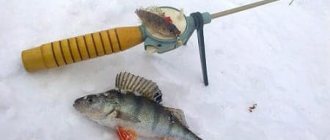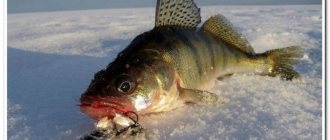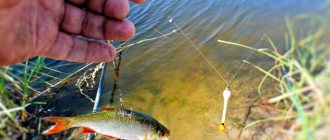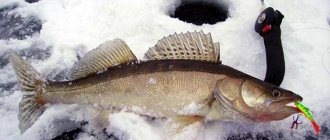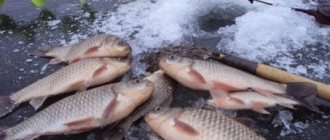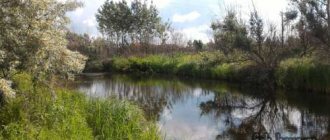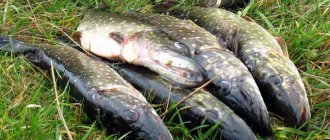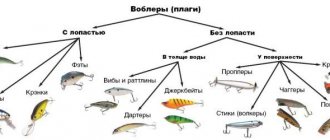Live bait rig
Regardless of the design of the girder, you will need a device on which to attach live bait. It consists of one or two hooks, doubles or tees, a wire or tungsten leash, and a snap hook with a clasp. If a live bait is attached to a hook, they try to hook it in such a way that it is less injured - by the lip, near the edge of the anal fin, by the back near the edge of the dorsal fin. The longer the live bait is alive, the better. At the end of fishing, if it is in normal condition, the live bait from the hook can be completely released into the reservoir.
The simplest thing is to use a tee, which is attached to the end of the leash, and hook the fish by the lips. Sometimes they use a live bait tee with one small hook on which live bait is placed, and large ones for the predator, or the same double. The hook size is at least number 10 or larger. It is better to use two hooks. One is placed on a leash and slides freely along it, preferably on an additional wire bend, so that there is another degree of freedom. The second one stands at the end of the leash. The first hook is placed under the fish's anal fin, the second - behind the lips.
As practice shows, you should not use rigs that involve passing live bait through the mouth and gills. With this method, the fish lives much shorter than if it is simply attached to the lip, and is less mobile in the water. Consequently, there will be fewer bites on it. Now on sale there are various clips for live bait, with which you don’t have to pierce them with hooks at all. However, their feasibility must be verified. In addition, it is not known what is worse for the fish - a squeezing clamp that interferes with movement, or a small puncture in the lip and tail muscles. There are even more designs of live bait rigs than designs of girders, and the final choice of the fisherman must be tested by practice - which pike will spit out less often and take more often.
The main line for the girder should not be thinner than 0.25 mm. Even if a small pike bites, a 0.25-0.3 fishing line is convenient because it can be pulled out of the snow or ice if it is frozen. With a thinner, albeit good and strong fishing line, this will not work; it freezes very tightly and immediately. When winter fishing, braided cord is never used on girders.
Fishing
Hooking occurs when the baitfish is deeply swallowed by the predator. Therefore, a metal leash is required in the equipment. Otherwise, the line may break when the fish begins to fight at the bottom of the edge of the hole. The main task is not to let her come to her senses. It is necessary to bring the fish to the hole and immediately release it, holding the fishing line. Then repeat this process again several times. When she gets tired, it will be possible to catch her with a hook under the lower jaw.
Read: Winter perch fishing at a glance
It's hard to say when fishing will be successful. But experienced fishermen notice that on sunny days the predator is passive. While on cloudy days and during a thaw, you should expect a good catch.
Finally, I would like to remind you that fishing on first ice is an extremely dangerous activity, given the heterogeneity of its surface. Believe me, going under the ice is not fun at all and you certainly won’t get any pleasure. Go out on the ice only if you are absolutely sure of its strength.
Live bait for pike
As practice shows, it makes sense to choose the size of live bait based on the size of the fish. Typically, pike take well on fish that are about ten times less than their own weight. For example, to catch a one-kilogram predator you will need a hundred-gram live bait, and for half a kilo you will need fish weighing 50 grams. This is a fairly large live bait. Live bait from 30 to 100 grams should be considered universal. Even a small pike can bite on live bait with only half its own weight, and a large five-kilogram pike can be tempted by small fish. There is no need to be too attached to the size of the bait, just don’t be afraid to hook fairly large fish. Usually they are caught using several baits, for which you can use different caliber live baits, which will increase the chances.
It makes the most sense to use those live baits that live in the fishing area. They are common food that does not cause suspicion. You can usually catch them right at the fishing spot using a jig and a float rod. However, it happens that live bait refuses to bite. Therefore, it is better to take some purchased live bait or one caught in another body of water when fishing, so as not to be left without a tail. And then, when you manage to find the key to the fish, catch local live bait.
When purchasing, you should pay attention to the breed of fish. The simplest and most affordable live bait for pike is roach. Sold from 5 to 30 rubles per piece, depending on the region. It is better to buy live bait from a hook, since live bait from a net has frayed fins and damaged scales; they are less viable. Also, the purchase should be made immediately before fishing in order to worry less about safety.
Roach has the shortest “shelf life”. Crucian carp, perch, and ruff will last a little longer at home. You can use lamprey, rotan. The latter should be taken with caution, as there is a risk of introducing a weed species. Of course, it is not a competitor for pike and perch and will be quickly destroyed. But if it turns out that there are none in the reservoir, it can multiply and create problems. In order for live bait to live longer, it should be kept in cold water. Ice from the refrigerator, or preferably from the street, is added to the water. It is advisable to put one large piece there and cover it with a lid, so it will take longer to melt. Those who have an aquarium compressor use it. In large stores, to preserve live bait, they use special oxygen bags that are placed in the water.
In order to move live bait around the reservoir, it is convenient to take a cane and a trough-sled. A can, a box, a bag with lanyards, and an ice auger are placed on the trough and travel to the fishing spot after the angler. In your hands, all this rubbish will interfere with walking, and the voluminous can of water is also heavy. Therefore, a trough is a mandatory attribute for those who plan to seriously fish with girders.
Catching live bait on the spot
For fishing, use a jig and a float rod, with the thinnest fishing line and a small hook. Chernobyl, bloodworms, worms, and dough are used as bait. Sometimes small perch are caught using small spoons. A universal live bait tackle must be recognized as a small balalaika fishing rod with a very thin fishing line and the smallest tungsten jig. You can bait dough on it too, the roach doesn’t really understand that it’s a non-living bait and takes it as if it were a living one.
It is better to select jigs so that, with the same light weight, they have different hook sizes. This is necessary so that the bait does not swallow the hook and gets caught right behind the lip. To extract, you must have a small extractor. It is convenient to have two or three pre-equipped live bait fishing rods with different hooks on jigs for different sizes of live bait.
The main thing is to position yourself so that the placed girders are in sight, and the kana is at hand. The caught fish is placed in it. Usually, in the cold, fish do not sleep like they do in summer, and there is no need to take additional measures to preserve them in the can. Therefore, it is very important to position the place for live bait fishing and setting up the bait. The place where pike is caught is taken into account, the place where the live bait bites and the direction of the wind, to which it is advisable to sit with your back or at least sideways, covering the hole and the nod of the fishing rod with your boot from the wind. If this is not possible, you should keep your ears ready and react to the click of the flag in order to run and hook.
During live bait fishing, they are often caught using several rods. To do this, drill two or three holes side by side in the selected location. They put jigs and float winter fishing rods in them, which should all have stands. They use alternating play on different gears. It happens that a fish is attracted by a jig, and then only bites on a float rod with a fixed attachment, and this does not work in any way.
If you find a good place for live bait, it makes sense to feed it a little in order to delay the flock. They use neutral bait compositions and homemade porridges. The fish will stay in place longer if there is some food for it. But you can’t hope to attract fish to a place where there are none now by feeding them. Smells, even the most delicious ones, spread weakly in cold water, and in winter it is easier to attract a flock of live bait by playing with a jig than with the most expensive and tasty bait. In any case, if there are no bites for a long time, you need to change the fish and look for it, and not hope that it will come on its own. Usually, where the live bait is found, there is also a pike, and it is worth placing the girders there too.
When and where to fish?
Before you start catching pike on girders in winter, you should familiarize yourself with the periods and places of its active biting. Experienced fishermen say that the best time for fishing with this method is January and February. By these months, the pike is no longer so active and takes a standing bait perfectly. Also at this time, as a rule, the ice becomes quite strong and widespread, so you can safely stand on it while waiting for a bite.
The first piers are installed on the first ice mainly in January, but sometimes earlier - at the end of December. After the deep winter phase, the so-called last ice comes, which occurs around February. The activity of pike is increasing, and in places where this is possible, you can already start using spinning rods, but the effectiveness of the fishing rods does not decrease.
At the end of winter and in the first weeks of spring, fishing with girders becomes possible only if there is strong ice. Sometimes a fisherman faces a difficult choice: go to a small lake and fish with jigs, or go to a river with a strong current and start using spinning gear. You should start from your own experience. Depending on weather conditions, fishing efficiency will be much higher with one method or the other.
It is best to start looking for a place to fish from small lakes. Due to their small size, they are the first to begin to become covered with ice, which means that fishing on them will begin earlier.
Looking for pike in different bodies of water is not difficult, because it lives almost everywhere. The most difficult thing is to decide on the place where the vents will be installed. For all of them there is a general rule - the presence of various snags, tree roots or dense vegetation. It is these places that are best prepared for fishing, since predatory fish are found here more often - they have an advantage over their prey, hiding behind a tree root or in thick algae, which is why they hunt in such places in the reservoir.
In winter, the behavior of pike, like the behavior of many other fish, is greatly influenced by the weather. On cloudy, not very cold days with a south wind or no wind at all, pike fishing is best. However, most winter days are frosty, clear, with a cold north wind. During this period, the fish moves closer to the bottom and its activity decreases.
The time of day does not have such a strong effect on the catch. But it’s worth knowing that pike bite best on bait in the evening and at night. The undesirable time for fishing is the period after dawn and before late lunch, that is, until 15:00.
Fishing for large and small pike is best done during the periods and conditions listed above. However, this does not limit fishermen in any way; they can go for catch at any time.
Tactics for catching pike on girders
First ice is best suited for fishing, when the pike has a mad hunger. Fish from open places, windy and cold, rush under the bays, backwaters, and small tributaries closed by the first ice. Usually, weather changes act as a stunning factor; small fish are not able to resist and run away from pikes, or notice them in time. The predator takes advantage of this and actively eats before the long winter.
The depth in the fishing areas is usually small - up to two meters. And more often the pike even takes it at a depth of a meter. This is good - after all, the ice is thin, and if you fall through, you can feel the bottom with your feet and get out. However, you should not forget about safety measures - be sure to take life preservers and a rope. It is best to use local live bait. Pike eats all small fish - perch, roach, silver bream, ruffe. The only thing is that you should not put small specimens of valuable fish - pencil squints, bay bream. You can catch them, but they can grow and become a worthy trophy, give birth to offspring and provide a catch in the future. It's better to let them go.
It is best to fish with rigs with 150 drills. The fact is that the pike bends, and it is quite difficult to get it into a small hole. And the size of the trophy may be such that it simply does not fit into a small hole. However, if you catch from 130, you can do it that way. However, you must be prepared for the fact that you will have to drill a hole if a steamer bites.
For pike fishing, a hook is also required. It allows you to pick up fish under the hole and drag it in without fear for the safety of the fishing line or hooks. The length of the hook should be greater than the thickness of the ice, it should be foldable and fit into the fisherman’s pocket, always at hand. Sometimes they use homemade hooks from old telescopic antennas for the receiver, attaching a handle and a hook to them. Fish weighing more than a kilogram must first be brought to the hole, then they are picked up and only pulled out onto the ice with the help of a hook; without a hook, only small squinting fish can be pulled out.
For pike fishing, it is advisable to have, in addition to an ice drill, an ice pick. Fortunately, there are also collapsible picks on sale, otherwise there would be difficulties with transportation. It is much easier for her to widen the hole if a trophy is bitten than to drill out with a drill. If you had to drill, it is done like this.
- Next to the hole, another one is drilled at a distance of half the diameter.
- Then the drill is placed so as to drill a third hole between the existing ones, connecting them into one longitudinal section. You have to drill very carefully. Semicircular knives are better suited for this task, while stepped knives are worse.
- At the same time, the fish must be turned purple and the partner holds a hook in his hands. Without a partner and a hook, it will be difficult to pull her onto the ice. There is a risk of cutting the line with a drill and the fish will leave.
- If there is no partner, you can only hope for the strength of the fishing line and hooks and release the fish under the ice, releasing the fishing line while they work on the holes.
- If you drill right next to the first hole, there is a very high risk of breaking the drill. It is better to drill three holes and not break the drill than to try to expand it by drilling a second one at once and break it.
To fish for girders, you need to have a metal scoop on hand. With its help, you can not only remove crumbs from the holes, but also easily destroy the frozen crust of ice without much risk of damaging the fishing line. This won’t work with a plastic scoop—you’ll have to use a knife, rescue rope, or other objects to destroy the ice, and then remove it. The holes under the girders stand for a long time, and ice can freeze, despite not very severe frost. It is advisable to tie the scoop to a belt on a string so that immediately after hooking you can remove the ice and holes and pull out the predator without having to dismount, without fear of forgetting the scoop in the sled.
Fishing places in the wilderness
Closer to the deep winter, the pike leaves the shallow water, which freezes first, to a decent depth. Its bite becomes more careful, the tuck needs to be set weaker. To the girders where the flag went off, you no longer have to go, but run headlong. January and February pike often spit out live bait as soon as they are pricked, and timely hooking is very important here. If the pike doesn’t bite in the old places, it makes sense to go looking for it with a balance beam, spoon, echo sounder and other devices. If there are signs of fish, it makes sense to put girders here and do something else.
Despite all sorts of fishing tips, pike bite approximately the same at both low and high pressure. The bite improves a little better with increasing pressure, that is, when moving from low pressure at 745-748 to high pressure at 755-760. But if these transitions are abrupt, the pike may stop biting altogether. It is best to choose periods with stable pressure and weather for fishing. This will not only allow you to catch fish, but also be sure that in the middle of fishing it won’t suddenly rain, for which the fisherman is not prepared.
The girders themselves, regardless of the presence of bites, should be walked around and checked every hour. They change the fallen baitfish. It happens that there was a bite, but the bait didn’t work. The live bait needs to be replaced, as it is injured and will no longer run after the pike bites. It happens that the live bait twitched, freed itself from the hook and ran away. From all the holes where the girders are located, the ice crust on top is removed so that it does not freeze further and thicker. If there are no bites, they begin to look for the reason: they change the release of the line with live bait, change the holes on which the girders are located. New holes are drilled and some of the vents are moved to another location.
Fishing restrictions
The permitted number of girders, as a rule, is no more than ten per fisherman. If there are no bites, it usually takes no more than fifteen minutes to go around and check them once an hour. In between, you can fish for live bait or other fish. For example - perch using a spoon, if there is enough live bait. You can go chat with other fishermen and find out how they are doing. It may be worth moving closer to them and rearranging the gear if they have more bites. In general, fishing with girders presupposes that there are other gears available so as not to sit idle.
When fishing with such gear, you cannot use a tent or stationary shelter. The fact is that you can’t see anything in the tent, you can’t hear anything. You have to do the hooking belatedly, hoping for a self-hatching. If this happens on the first ice, then in the dead of winter you can’t hope for it, and the girders will simply stand there in vain, not yielding a single fish.
On the contrary, the use of mobile equipment, such as dogs and snowmobiles, when fishing with girders is desirable. On a dog, you can place the girders widely, covering a large area of the reservoir, move quickly and always be in time when biting. It is not necessary to keep the dog in pairs; it is enough if it starts well. Starting and driving up will be faster than running a hundred or two hundred meters. At the same time, the trough with things will always be in the trailer, and there is no need to be afraid that you forgot the hook or cana in it, running to the bite without everything. Otherwise, you’ll have to yell at the whole pond that I’m holding fish, help me, bring me a hook, an ice screw, or something else. Also, if the piers are wide, you need to take binoculars with you. It may be unclear from a distance whether the flag worked or not. Then they take binoculars and make sure whether they need to go or whether there was no bite.
Catching other fish with winter baits
Pike is not the only fish that is caught with girders. In the wilderness, burbot becomes a worthy trophy. He bites on live bait, on fallen bait (but fresh!), on worms, and on other baits that may require less fuss. True, mostly at night and in the most severe frost, which is not always convenient for the fisherman. For night fishing, fireflies are attached to the flags. They use the lightest ones so that they do not upset the balance of the flags and do not outweigh them; they simply sew them to the flags with threads. If there is a full moon, the flags will be visible at night and without fireflies.
When fishing with small live bait, perch is often caught along with pike. These can be any species - from small perches weighing 50 grams to handsome one-kilogram beauties. Most often this happens during the first ice, when perch and pike stand in almost the same places, then the pike moves deeper. For perch you need to use live bait weighing no more than 30-40 grams. Such live bait is rarely available for sale; it is usually caught right there at the site where the girders are installed.
Pike perch is a rare trophy when fishing with live bait in winter. It is not very active at this time of year, much less perch and pike. However, where they found a pike perch trail, it makes sense to put a couple of girders. They can show whether a fish has approached or not, even just by triggering a flag without taking it. This means that you can take a spoon, a balance beam and move to the place where this predator is caught.
Rotan is another fish that can be caught very well on a winter bait. They do not use live bait as bait, but a worm; they do not use any leashes. It practically does not survive where there is a pike, and there is no need to be afraid that it will bite off the fishing line. Rotan bites actively, especially at the beginning of winter on the first ice. They usually manage to place no more than five zherlits - while they are placing them, the first ones are already starting to peck, and they don’t have time to do any more. This kind of fishing is much more effective than catching rotan with a spinner, jig and other baits with one or two rods and allows you to quickly localize its accumulations in the pond. You need to put a 0.25 line and a weak tuck on the girders, you have to run quickly to the bite, since the rotan will then swallow the hook deeply, and you will have to pull it out with the throat.
